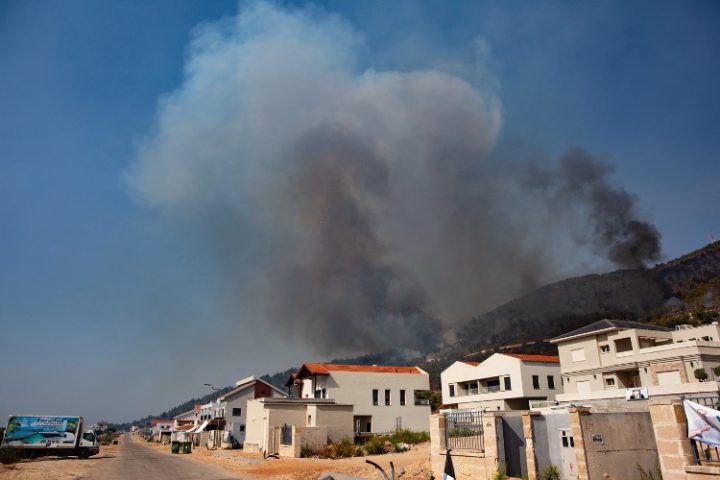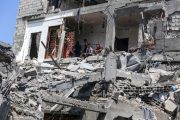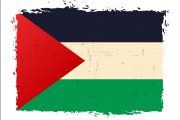
Early on October 23, Israel pounded Gaza with air strikes while its aircraft struck southern Lebanon overnight, as Israeli Prime Minister Benjamin Netanyahu gathered his top generals and his war Cabinet to evaluate the intensifying conflict, amid worries that the Israeli-Lebanese conflict would spread to other countries.
Palestinian media reported that Israel’s attacks focused on the Gaza Strip’s center and north.
Hamas officials claimed more than 60 people “were martyred in the [Israeli] raids,” including 17 who died in one strike that hit a house in Jabalia, in northern Gaza.
In the Israel-occupied West Bank, two Palestinians were killed at the Jalazone refugee camp near Ramallah, the Palestinian Health Ministry announced on October 23.
Residents told Reuters that Israeli forces conducted raids on the camp and made widespread arrests, as they had a faceoff with some gunmen and youths who hurled stones.
More than 4,600 people have been killed in the Gaza enclave since the Israeli bombardment began earlier in October.
Israel’s air strikes came in response to a brutal attack by terrorist group Hamas on October 7, during which at least 1,300 Israelis were killed and wounded by Hamas militants, and hundreds taken hostage into Gaza.
Palestinian Hamas leader Ismail Haniyeh and Iranian Foreign Minister Hossein Amir-Abdollahian spoke in a call late on October 22 regarding ways of halting Israel’s “brutal crimes” in Gaza, Hamas revealed in a statement.
Israel has assembled tanks and troops near the fenced border around Gaza for an intended ground invasion aiming to eradicate Hamas.
On its end, the United States cautioned against a huge risk to U.S. interests in the Middle East.
“What we’re seeing … is the prospect of a significant escalation of attacks on our troops and our people throughout the region,” U.S. Defence Secretary Lloyd Austin told ABC’s This Week program on October 22.
Moreover, Washington declared a new deployment of advanced air defenses.
Notably, the Pentagon has already sent a considerable amount of naval power to the Middle East, including two aircraft carriers, support ships, and about 2,000 marines, to forestall attacks by Iran-affiliated forces.
China’s Middle East special envoy Zhai Jun also warned that the risk of a large-scale ground conflict was increasing and that regional spillover conflicts were “worrisome,” the Chinese state media said on October 23.
Early on October 22, Israeli missiles struck Damascus and Aleppo international airports in Syria where Hamas’ main regional supporter Iran has a military presence, putting both facilities out of service and killing two workers, Syrian state media reported.
Along Israel’s northern border with Lebanon, the Iran-backed Hezbollah group has been involved in skirmishes with Israeli forces in the deadliest escalation of frontier violence since an Israel-Hezbollah war in 2006.
Early on October 23, Israeli aircraft struck two Hezbollah cells in Lebanon that were planning to fire anti-tank missiles and rockets toward Israel, its military said.
Israel’s military also disclosed that it hit other Hezbollah targets, including a compound and an observation post.
Hezbollah said on the same day, October 23, that one of its fighters was killed, without elaborating. On its end, Israel’s military said seven troops have been killed on the Lebanese border since the most recent escalation of violence started.
On October 22, Israel added 14 communities close to Lebanon and Syria to its evacuation contingency plans, after enacting a plan last week to evacuate residents out of 28 border-area villages, as well as the nearby town of Kiryat Shmona, with state-funded temporary accommodation.
Palestinian Prime Minister Mohammad Shtayyeh urged the international community to form “a united front” to halt Israel’s military actions against Gaza and permit aid which has only begun to seep in slowly.
On the night of October 22, the blockaded Gaza Strip received the second convoy for 14 aid trucks entering the Rafah crossing.
U.S. President Joe Biden and Israel’s Netanyahu reinforced in a call that “there will now be continued flow of this critical assistance into Gaza,” the White House disclosed.
The UN humanitarian office remarked that the volume of aid entering the Gaza Strip thus far was only four percent of daily average amounts of aid before the tensions escalated, as well as a fraction of what was required with food, water, medicines, and fuel stocks running out.
On Sunday, Biden also arranged a separate call with Pope Francis and also spoke with the leaders of Canada, France, the U.K., Germany, and Italy about obtaining aid for Gaza and preventing the conflict from spreading.
In a joint statement, the leaders articulated support for Israel’s right to defend itself.
They also called for international humanitarian law, including the protection of civilians, to be adhered to.
Netanyahu also held a phone call with the leaders of France, Spain, and the Netherlands, the Israeli leader’s office said.
Around 20,000 people have been internally displaced in south Lebanon and elsewhere since early October, a UN agency proclaimed on October 23, as tensions rise on the Lebanese-Israeli border following the outbreak of the Gaza war.
The International Organization for Migration said 19,646 people had been displaced inside Lebanon since it began monitoring movements on October 8.
The agency said the movements were mainly caused by those escaping the south of Lebanon, while some people have also relocated from other areas.
Many who have left south Lebanon have moved north to the coastal city of Tyre, which is 18 km from the border.
Inaya Ezzeddine, a lawmaker from Tyre, admitted that the movement was imposing a toll on families housing the displaced and the government of a country grappling with an economic crisis.
“This war is happening amid a very big economic crisis and people don’t have provisions,” Ezzeddine said, adding that around 6,000 people had sought refuge in Tyre and three schools had been used to house some of them.
“We cannot open all schools because schools are still operating, every school we open we’re depriving its pupils from using it,” she continued.
School teacher Yolla Ali al Swaid fled to Tyre after she was wounded in the shelling that struck her home in the border village of Dhaira, an area where there have frequently been exchanges of fire.
“The school’s four floors are all full. We’re 11 people in the room with my sister’s family,” Ali al Swaid told Reuters, adding the crowding was encouraging some people to consider going back home.
“There are people who are thinking about hanging white sheets on their homes when they go back there,” said Swaid, who also fled her home in the war in 2006.
Hezbollah says 27 of its fighters have been killed in the fights since October 7, while Lebanese security sources say 11 fighters from Palestinian groups in Lebanon, which were linked to Hezbollah, have also lost their lives.



